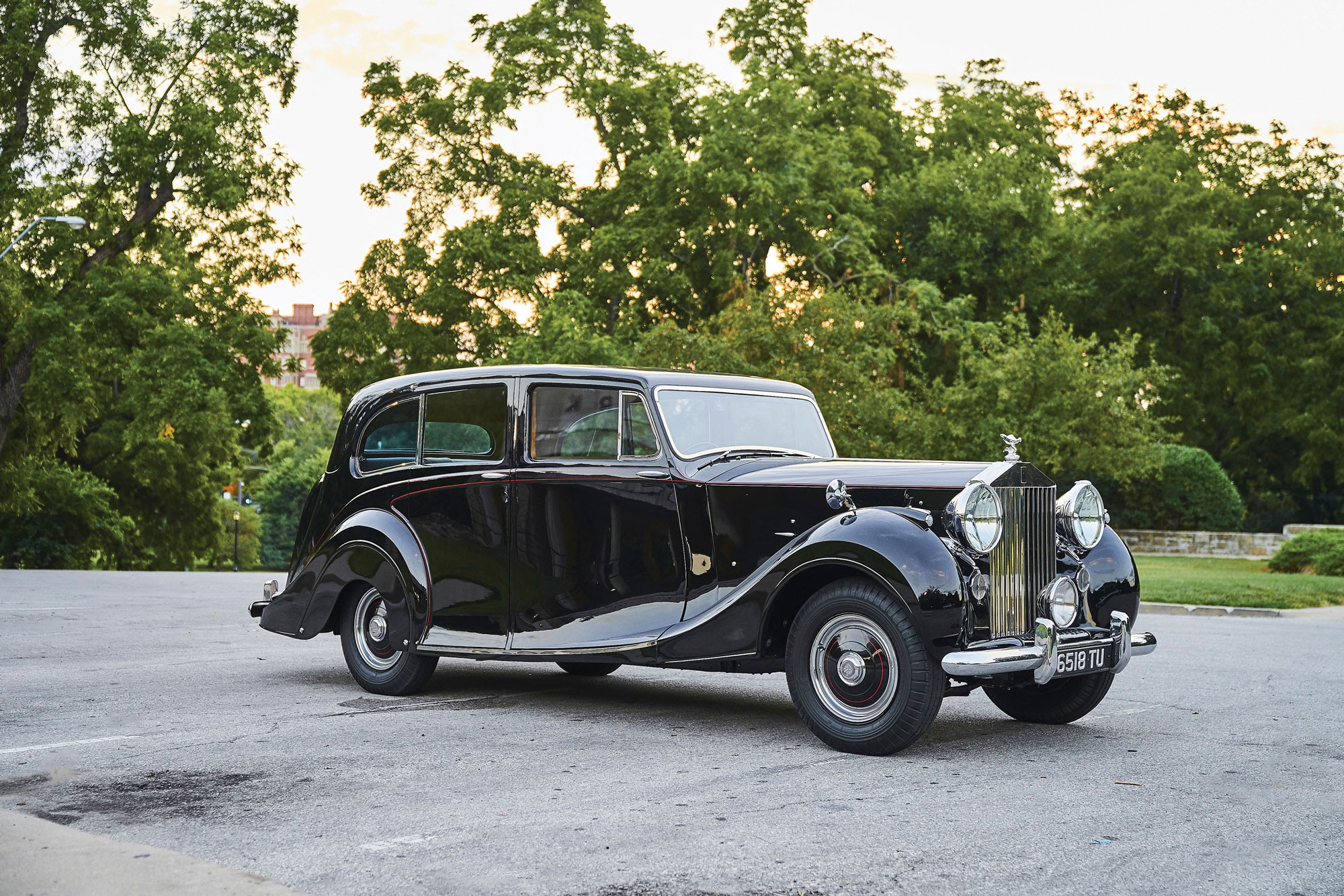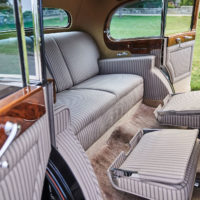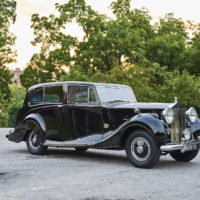The English coachbuilder Hooper produced many types of bodies upon the Silver Wraith chassis, but among its rarest and most formal designs is the 7-passenger limousine, as offered here.
Just 10 examples of these hand-wrought aluminum beauties were created between 1947 and 1951; the first was built for Lord Louis Mountbatten in his service as Viceroy of India. The last, offered here, was delivered new to the United Kingdom’s most powerful media mogul, The Right Honorable James Gomer Berry, 1st Viscount Kemsley.
From 1920 until 1955, Lord Kemsley enjoyed considerable political influence on account of his 22 major newspapers. He was also the patron of several authors, most notably Ian Fleming.
Maintenance records from the Viscount’s ownership indicate rear-cabin modifications undertaken in July 1952 by Hooper to replicate several features as found on the Aga Khan’s famous Phantom IV Sedanca de Ville, in which Kemsley had recently traveled. These modifications included the fitment of tinted purdah glass, special silk rope pulls, an armrest storage box with newspaper cubby, supplemental reading lights, and interior mirrors.
Rather interestingly, the sale of WME85 is accompanied by a special coin set and pin given to Lord Kemsley during Queen Elizabeth II’s coronation in June 1953. The consignor discovered these items wedged under the rear seat, presumably misplaced there during the coronation festivities.
By late 1956, Lord Kemsley had sold WME85 back to Rolls-Royce, and it was subsequently given the factory registration plates “6518 TU” for use as a diplomatic limousine in service of the British government. These registration plates remain with the car to the present. The car was discovered by the consignor in 1997. At the time, its odometer indicated just under 12,800 miles, and was reportedly in an extremely original but disused state.
Since emerging from its restoration by renowned marque specialist Ralph Curzon, WME85 has won numerous awards at several important national-level Rolls-Royce Owners’ Club events, including Best in Show and Finest Hooper Car twice. Furthermore, it was awarded a coveted People’s Choice prize at the Meadow Brook Concours d’Elegance.
SCM Analysis
Detailing
| Vehicle: | 1951 Rolls-Royce Silver Wraith Limousine by Hooper |
| Years Produced: | 1946–59 |
| Number Produced: | 1,883 (all body styles) |
| SCM Valuation: | $23,000–$107,000 |
| Tune Up Cost: | $350 |
| Chassis Number Location: | Firewall plate |
| Engine Number Location: | Lower left side of engine block |
| Club Info: | Rolls-Royce Owners’ Club |
| Website: | http://www.rroc.org |
| Alternatives: | 1949–55 Rolls-Royce Silver Dawn, 1946–52 Bentley Mk VI, 1951–62 Mercedes-Benz 300 Adenauer sedan |
| Investment Grade: | C |
This car, Lot 366, sold for $90,750, including buyer’s premium, at RM Sotheby’s Hershey, PA, auction on October 5, 2022.
Even before World War II, Rolls-Royce realized it was going to have to change its time-honored but inefficient methods of building cars. Plans were made for a rationalized range of F-head engines in 4-, 6- and 8-cylinder forms. (The 4 was never used in an automobile, and the 8 appeared only in the hyper-exclusive Phantom IV.) A series of cars was developed to use standardized steel bodies rather than only coachbuilt ones.
An early version, the Bentley Mk V, appeared in late 1939, but only 12 examples were built before production was halted by the war. With some further modernization, its successor, the Bentley Mk VI, appeared remarkably quickly after the war in early 1946. It was later accompanied by the similar Rolls-Royce Silver Dawn.
Despite Britain’s post-war austerity, there was pent-up demand for luxury automobiles, and the Mk VI was a smash hit in Bentley terms, with 5,201 built before it was superseded by the Bentley R-type in late 1952. Rolls-Royce didn’t abandon its traditional chauffeur-driven customers, however, and in late 1946 it introduced the Silver Wraith, using essentially the same drivetrain on a lengthened chassis. Silver Wraiths wore bespoke bodies from a variety of coachbuilders, often H.J. Mulliner, Park Ward, James Young or Hooper.
Not for you
Lord Kemsley’s Silver Wraith is Hooper Design No. 8195, constructed on an even longer chassis that debuted in 1951, so large and lofty it could be mistaken for a Phantom IV. Coachbuilders had requested this longer wheelbase for formal motorcars such as limousines, as only royalty and heads of state were eligible to buy Phantom IVs. Queen Elizabeth had one (still in the Royal Mews today) as did Princess Margaret and various potentates and dictators. Only 19 were built, all with the inline-8 engine. For a non-royal mogul like Lord Kemsley, a formal Silver Wraith was the next best thing.
This rather bulky Hooper design certainly isn’t the most graceful body ever seen on a limousine, and the freestanding P-100 headlamps were an anachronism even in 1951. But the car is undeniably impressive and must have been a jaw-dropping sight on London streets among the post-war Ford Prefects and Morris Minors. The interior materials and craftsmanship are exquisite, as expected of a coachbuilt Rolls-Royce.
It may surprise those unfamiliar with these cars to see the shifter for the 4-speed manual transmission between the driver’s seat and door, but this is correct. An adaptation of GM HydraMatic automatic didn’t appear until 1953. The manual is silky-smooth in operation, perhaps the most satisfying mechanical aspect of an early post-war Rolls-Royce or Bentley. I enjoy its seeming incongruity with a stately limousine. Note also that power steering did not arrive until 1954.
Fit for a queen
Our subject car was restored to a high standard over six years starting around 2000, and still shows well today. There are now minor paint flaws, and the varnish on the dashboard wood shows rippling and wear. A few other nits can be picked, but overall, it appears that the car has few needs.
From 1946 to 1959, 1,883 Silver Wraiths were built, with 639 constructed on the longer wheelbase. They were always a bit archaic but slowly evolved. It was the last Rolls-Royce model to be fitted with such a wide range of coachbuilt bodies — some of which, it must be said, were quite hideous, as coachbuilders explored various paths from pre-war styles to modernity. For years, some in the Rolls-Royce community derided Silver Wraiths as being bulky and stuffy, but more recently there has been a new respect and interest in the variety of body styles and designs.
Not surprisingly, Silver Wraith values vary wildly, often rendering price guides worthless. Rare coupes and convertibles can sell at high price points. Several drophead coupes have sold for between $200k and $475k during the past three to five years, and there have been a few outliers even higher than that.
Majestic limousines like our subject car are the next-most-coveted Silver Wraiths. They are not practical for the owner-driver with a normal garage, but they are certainly works of art, artifacts of a bygone era. In nice but not concours condition they generally sell for between about $80,000 and $150,000, depending on condition and styling. Decent saloons and smaller touring limousines can be had for as little as $40,000, but more typically sell for $60,000 and up.
Our subject car, given its provenance, older high-quality restoration, low mileage and current #2 condition, was well bought at the lower end of its $85,000–$125,000 pre-auction estimate. The Queen Elizabeth coronation souvenirs were a little icing on the cake. That said, it may not have been the best investment.
The Silver Wraith market, while wide ranging, has been stagnant for years. Digging a little deeper into the SCM Platinum Auction Database, we last saw WME85 in 2006, when it was a no-sale at $95,000 in Christie’s 2006 Monterey auction (SCM# 1567130). At the time, the restoration was undoubtedly fresh, but over the past 16 years the car has clearly gone nowhere in value.
All of the early post-war motorcars from Rolls-Royce and Bentley are reliable and delightful tour cars, eminently drivable in modern traffic. There is steady-but-limited demand among those who love them, but also an entirely adequate supply. The market for the somewhat smaller touring limousines and saloons, in particular, might have some chance of a gentle rise in the future as younger buyers discover their charms, but I certainly would not advise buying one as an investment. ♦
(Introductory description courtesy of RM Sotheby’s.)


